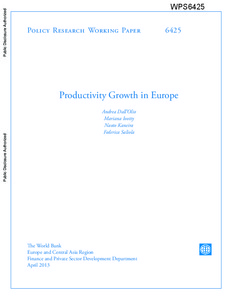Productivity growth in Europe
"This paper tests whether structural or firm-specific characteristics contributed more to (labor) productivity growth in the European Union between 2003 and 2008. It combines the Amadeus firm-level data on productivity and firm characteristics with country-level data describing regulatory envir...
| Main Authors: | , , , |
|---|---|
| Institution: | ETUI-European Trade Union Institute |
| Format: | TEXT |
| Language: | English |
| Published: |
Washington, DC
2013
World Bank |
| Subjects: | |
| Online Access: | https://www.labourline.org/KENTIKA-19127504124919457869-Productivity-growth-in-europe.htm |
| Summary: | "This paper tests whether structural or firm-specific characteristics contributed more to (labor) productivity growth in the European Union between 2003 and 2008. It combines the Amadeus firm-level data on productivity and firm characteristics with country-level data describing regulatory environments from the World Bank's Doing Business surveys, foreign direct investment data from Eurostat, infrastructure quality assessments from the Global Competitiveness Report, and credit availability from the World Development Indicators. It finds that among the 12 newest members of the European Union, country characteristics are most important for firm productivity growth, particularly the stock of inward foreign direct investment and the availability of credit. By contrast, among the more developed 15 elder European Union member countries, firm-level characteristics, such as industry, size, and international affiliation, are most important for growth. The quality of the regulatory environment, measured by Doing Business indicators, is importantly correlated with productivity growth in all cases. This finding suggests that European Union nations can realize significant benefits from improving regulations and encouraging inward and outward foreign direct investment." |
|---|---|
| Physical Description: | 41 p. Digital |

